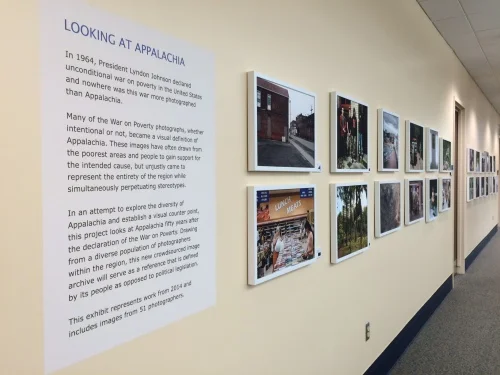FROM WVU PRESS RELEASE
The creators of two exhibits on display at West Virginia University’sDowntown Campus Library want their works to open up conversations about life in Appalachia.
Looking at Appalachia, the latest exhibit in the West Virginia UniversityLibraries’ Art in the Libraries series, is a juried collection of images by amateur and professional photographers that chronicles life in the 13-state region more than 50 years after President Lyndon Johnson’s War on Poverty. The pictures line the wall on the Library’s first floor.
“The greatest effect photographs can have is to encourage conversation,” said Roger May, director of the Looking at Appalachia project. “We see thousands and thousands of images a day. Many of those pictures may cause a brief emotional response, but how many of those pictures actually call us to action?”
May began his Looking at Appalachia project in 2014 to mark the 50th anniversary of Johnson’s Poverty Tour. Johnson’s tour was heavily covered by the media and generated several images that came to define the region. May initially planned to travel the entire region and take all of pictures on his own. But his responsibilities to his family and career as a professional photographer led him to a better option – crowd sourcing.
“It’s much more diverse body of work than it could have been as a singular vision of one person. It’s grown to be bigger than one person could have accomplished,” May said.
In the Downtown Campus Library Atrium, a companion exhibit showcases the award-winning documentary and participatory project Hollow, which was created by WVU alumna and West Virginia native Elaine McMillion Sheldon. The web-based interactive documentary examines the issues facing McDowell County residents and the reasons behind the massive exodus from the area over several decades.
“I’m excited for Hollow to be at WVU because it can reach a lot of new people,” McMillion Sheldon said. “The topic will resonant with students who have left home or are getting ready to graduate and thinking of leaving the state.”
Hollow won a 2013 Peabody award and was nominated for a 2014 News and Documentary Emmy Award. WVU Libraries holds the rights to Hollow and plan to make extra footage available to students; it can be viewed atwww.hollowdocumentary.com/.
Stills and informational graphics from the documentary welcome visitors to the Atrium. iPads and a computer allow people to watch and engage in portions of the film. Visitors also have the opportunity to contribute to the project by sharing their own migration stories and images of home.
McMillion Sheldon is eager for students from throughout the nation and even world to see the documentary and share their thoughts. Although Hollow focuses on Southern West Virginia, the website has registered visitors from around the world.
“It’s a story about a local community, but it’s got universal themes. It’s a global issue of young people leaving areas and those areas not revitalizing,” McMillion Sheldon said.
Alyssa Wright, chair of the Art in the Libraries Committee, hopes both exhibits will not only enliven the space in the Library but also spur related class assignments and out-of-class activities.
To assist faculty in incorporating the Looking at Appalachia exhibit into their courses, special tours and class visits by May will be available upon request.
The Art in the Libraries Committee is also forming a faculty panel for a public discussion of the social and cultural issues raised by the exhibit. Those interested in participating in the panel or who have questions should contact Wright at alyssa.wright@mail.wvu.edu.
This fall, the Libraries will host a reception and program to celebrate both exhibits. The exhibits will remain on display through June 30, 2017.
